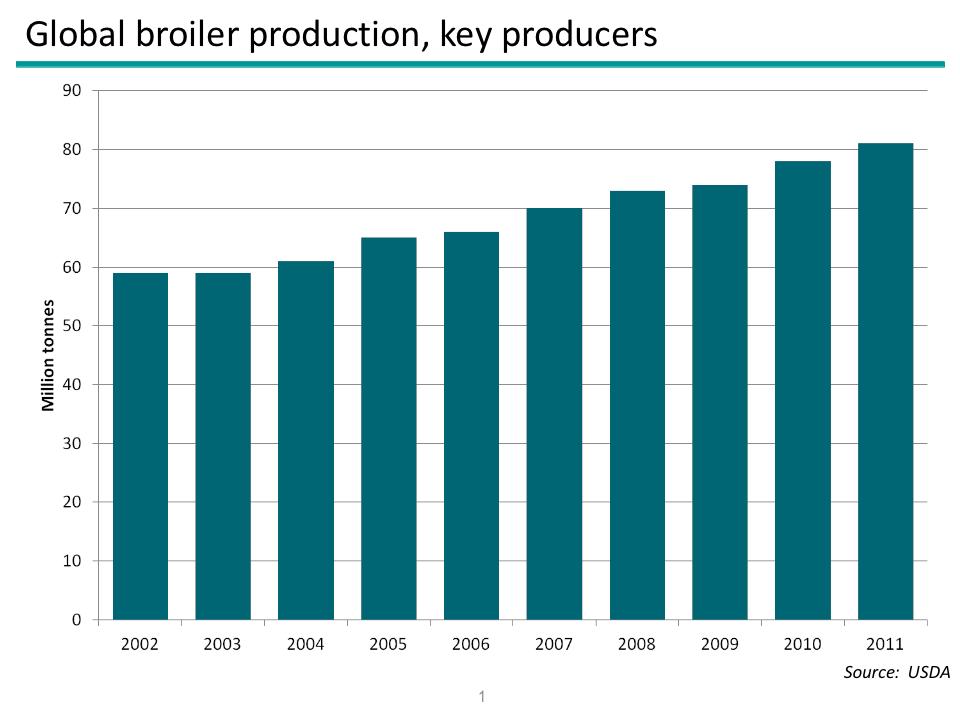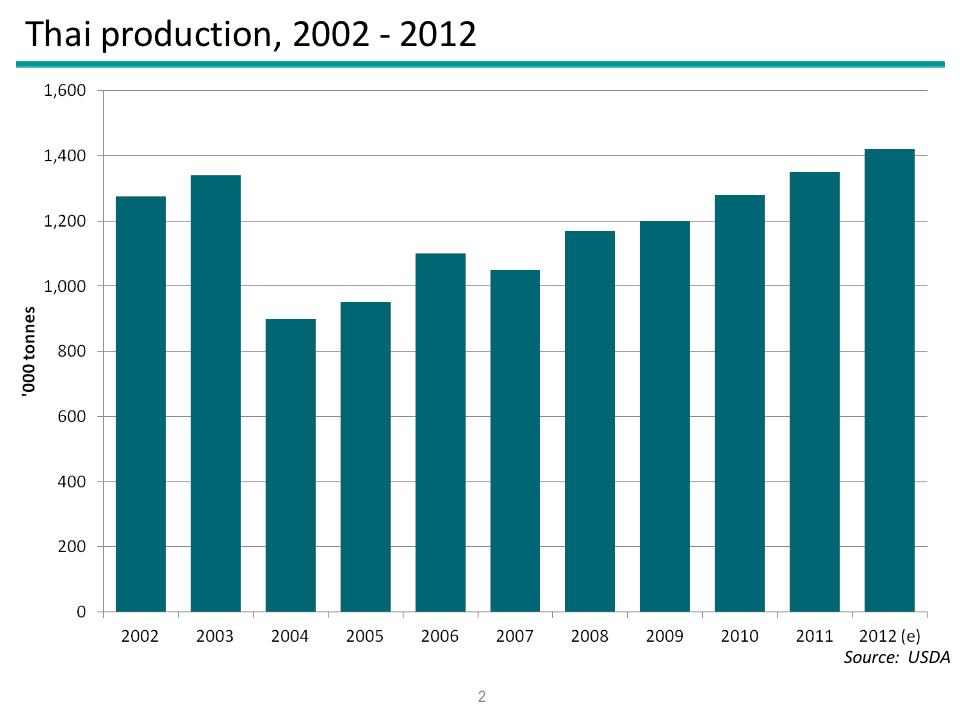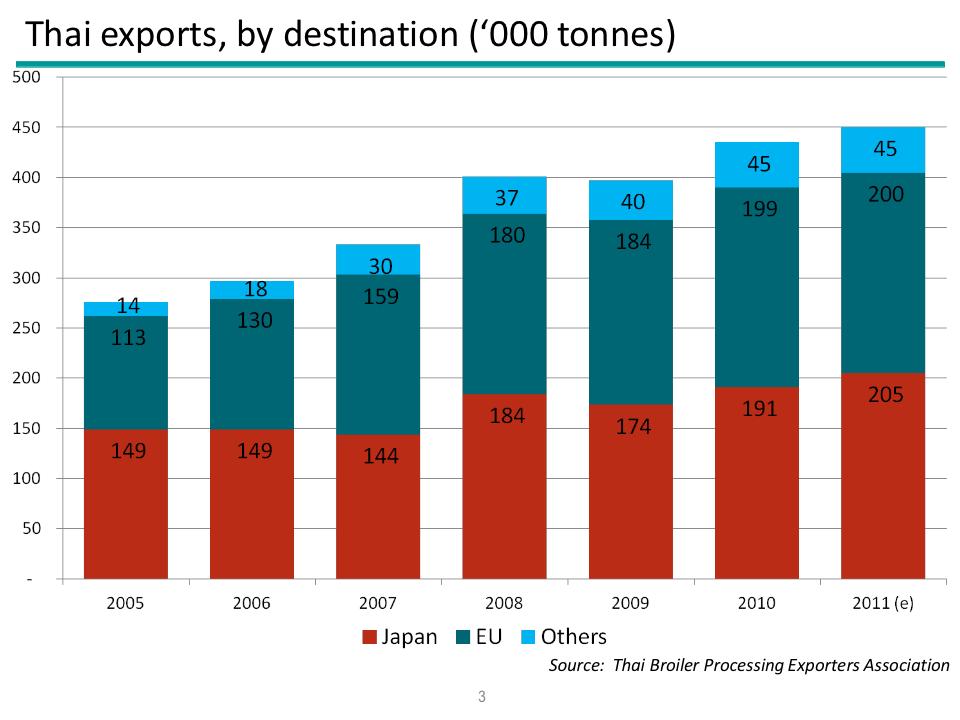Leading producers
The US is the largest broiler producer in the world – increasing by 16% between 2002 and 2011. This increased by 2.2m tonnes totalling some 16.7m tonnes in 2011. The US accounts for just over 20% of world production. 17% of US production is exported.
China’s production has increased 38% between 2002 and 2011, increasing from 9.5m tonnes to 13.2m tonnes – higher pork prices, a decrease in broiler imports and strong demand will result in positive growth for 2012 – increasing by 5% to an estimated 13.8m tonnes in 2012.
Between 2002 and 2011, Brazil’s production has increased by 74% to 12.9m tonnes in 2011. Brazil’s production is set to increase by 5% in 2012, increasing broiler production to 13.6m tonnes. EU-27 production has increased by 15% between 2002 and 2011, from 8.2m tonnes and 9.5m tonnes respectively. Production in 2012 is expected to increase modestly by 130,000 tonnes.
Globally, Thailand is now the 12th largest producer of broiler meat and production has increased 6% between 2002 and 2011, rising from 1.2m tonnes to 1.3m tonnes in 2011. Production is expected to increase by 70,000 tonnes in 2012.

Exports
Food and Agriculture Organisation (FAO) data suggest that global exports are currently at 10.7m tonnes and the value of these exports has increased by 144% in the last 10 years from US$7bn to US$16bn. In 2011, the largest global exporter of broiler meat was Brazil. This has increased by 109% between 2002 and 2011, exporting a total of 3.3m tonnes in 2011. Exports are expected to increase by a further 5% in 2012 – driven by sales to the Middle East, and other traditional markets such as Japan, Saudi Arabia and the EU.
US exports over the last 10 years have increased from 2.1m tonnes to 2.9m tonnes in 2011. EU exports have increased by 44% from 765,000 tonnes to 1.1m tonnes in 2011. This is driven by strong exports to Hong Kong, Saudi Arabia and Sub-Saharan Africa. It is expected that exports will slow in 2012 due to competitors expanding production in Brazil and China. Between 2002 and 2011, Thailand’s exports have increased by just 6%, increasing to 460,000 tonnes in 2011 and Thailand is now the largest global exporter of prepared and preserved poultry.
Imports
Back in 2009, Russia was the largest importer of chicken meat, importing c. 923,000 tonnes but this has declined to just 390,000 tonnes in 2011. This will continue to decrease as the Russian government has reduced the Tariff Rate Quotas and increased SPS (Sanitary and Phytosanitary Standards) measures.
Japan’s imports have increased between 2002 to 2011, by 12% from 744,000 tonnes to 840,000 tonnes in 2011, however imports are expected to decline in 2012 to 805,000 tonnes. Saudi Arabia’s imports have increased by 112% between 2002 and 2011 from 291,000 tonnes to 830,000 tonnes respectively. The EU-27 is the third largest importer of broiler meat globally. Mexico’s imports have increased by 132% between 2002 and 2011, rising to 590,000 tonnes in 2011.

The role of Thailand
Thailand’s broiler production reached 1.3m tonnes in 2011. It is predicted that production in 2012 will increase by a further 5%, reaching 1.4m tonnes. This increase is a result of fewer disease outbreaks and an increase in broiler production capacity. Production was at its lowest rate in 2004 (900,000 tonnes), due to the outbreak of HPAI (Avian Influenza).
The Thai poultry sector has heavily invested in broiler breeding farms and processing plants. Many breeding farms have integrated supply chains and are therefore in a good position to react quickly to market demands. Ongoing investment in processing facilities will allow the sector to increase total throughput to 3.85m birds per day. Fully cooked meat processing facilities have also been invested in for the increased demand for consumers in Japan and EU for cooked meat.
Exports are critical to the future of the Thai poultry sector. The EU and Japan are major export markets and account for 90% of Thailand’s total exports. Future growth in exports is likely to take place in Asian markets – Japan, ASEAN Countries, Hong Kong and South Korea. Exports will also increase when the HPAI ban is lifted on Thai uncooked frozen chicken. Countries that have lifted it included Hong Kong, South Africa, Bahrain and Russia.
The domestic Thai market is also strong, aided by expansion in the foodservice market, particularly the quick service restaurant (QSR) sector. There is an ongoing trend of integrated chicken producers representing all areas of the supply chain from poultry and breeding facilities to processing.

Future opportunities for Thailand in the EU
The EU has a large population base of 502m consumers and they still have a relatively high degree of affluence. The EU is the third largest import market in the world and poultry consumption is predicted to carry on growing. EU imports of poultry have been increasing – albeit at a relatively slow rate compared to other parts of the world.
Thailand has a recognised track record of supply to the EU – not just for poultry. Demand is concentrated in a small number of key EU markets and Brazil is the only major external EU competitor of note. Thailand has a concentrated poultry sector, is export competitive, enjoys relatively low costs of production and the routes to market are reasonably transparent. The way that the Common Agricultural Policy (CAP) operates provides specific access for Thai exports and does not really hinder Thai exports vis-a-vis other suppliers.
Taking into account all these factors, the future prospects for the Thai export sector remain good in the EU, as well as being able to exploit other opportunities in international markets especially across the Asian region.
John Giles is a divisional director with Promar International, which is the value chain consulting arm of Genus plc. John can be contacted at the following email: John.Giles@genusplc.com

